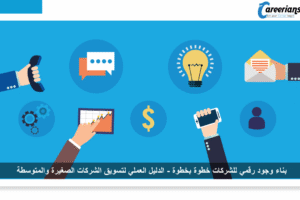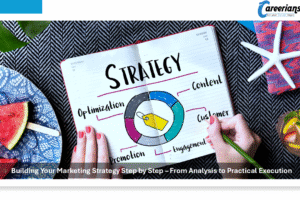
How to Build a Strong Digital Presence for Your Company – A Practical Guide for SMEs
How to Build a Strong Digital Presence for Your Company – A Practical Guide for SMEs in Egypt and the Gulf
In today’s world, your digital presence is your first impression — and often your only chance to win trust. for that cause, we present you Build a Strong Digital Presence step by step guide.
When someone hears about your company, they don’t ask a friend first — they Google you.
If your online image looks professional, they trust you.
If you’re missing or look unorganized, they go straight to your competitor.
The problem?
Most small and medium businesses in Egypt and the Gulf treat digital marketing like a temporary campaign or random post, not as a strategic ecosystem that builds reputation, engagement, and consistent sales.
This article is your step-by-step practical guide to building a solid digital presence, even with a limited budget — the Careerians way.
Step 1: Understand Why You’re Online
Before creating any page or ad, ask yourself:
“Why do I want to be online?”
Being digital isn’t a goal — it’s a means to reach specific objectives like:
-
Building brand awareness
-
Attracting new customers
-
Offering faster customer service
-
Driving online sales or bookings
Example:
A contracting company in Jeddah started sharing videos of real project progress, not ads.
Within months, potential clients started calling saying: “We’ve seen your work on Instagram — let’s start a project together.”
Step 2: Build a Professional Online Image
People form their opinion about your brand in three seconds.
Make sure your online presence reflects credibility and professionalism from the very first glance.
1. Create a Clear and Simple Website
You don’t need a complex website — you need an effective one:
-
Fast and mobile-friendly
-
Explains who you are and what you offer
-
Includes easy contact options (WhatsApp, forms, map)
-
Has strong CTAs (Call To Action): Contact us, Get a quote, Book now
2. Optimize Your Social Media Pages
Choose the right platforms for your business:
-
Instagram / Facebook: Great for consumer brands
-
LinkedIn: Perfect for B2B companies
-
TikTok / Snapchat: For younger audiences
-
YouTube: For storytelling and expertise building
Keep your visual identity consistent across all platforms — same logo, tone, and colors.
3. Use a Professional Email Domain
Never send business emails from Gmail or Yahoo.
Use your company domain (e.g., info@companyname.com).
It’s a small detail that makes a huge difference in how serious you look.
Step 3: Content is the Core of Your Digital Presence
Advertising attracts attention.
But content builds relationships.
People follow and trust brands that teach, help, or inspire them — not just those that sell to them.
Main Types of Content
-
Educational Content:
Explains how to choose, fix, or understand something. Builds credibility. -
Awareness Content:
Highlights problems in the market and how your company solves them. -
Promotional Content:
Used for offers, launches, or announcements — but keep it smart and valuable. -
Human Content:
Show your team, behind-the-scenes moments, success stories, and company culture.
People connect with people — not logos.
Step 4: Create a Clear Posting Plan
Random posting kills consistency.
Your audience needs to see you regularly to remember you.
Simple Monthly Posting Plan
| Week | Platform | Type of Content | Goal | Notes |
|---|---|---|---|---|
| Week 1 | Educational | Boost engagement | Reels / Carousel | |
| Week 2 | Awareness | Build trust | Text post | |
| Week 3 | Promotional | Drive sales | Limited offer | |
| Week 4 | YouTube | Human | Strengthen brand | Behind-the-scenes video |
Step 5: Treat Ads as a Tool, Not a Strategy
Running ads without a clear purpose is like driving blindfolded.
Ads accelerate success — they don’t create it.
Main Ad Types
-
Awareness Ads: When you’re new and want people to know you.
-
Engagement Ads: To build a community and visibility.
-
Conversion Ads: To sell, register, or generate leads.
Example:
A furniture company in Cairo spent one month only on awareness ads before launching a sales campaign.
When they finally did, sales exceeded EGP 200,000 in just one week.
Step 6: Analyze Your Performance Regularly
Without data, digital marketing becomes guesswork.
Every month, track metrics like:
-
Website visits
-
Engagement rate
-
Cost per lead
-
Ad ROI (Return on Investment)
-
Top-performing content types
Use Meta Insights, Google Analytics, or LinkedIn Page Analytics to understand what’s working — and what’s not.
Step 7: Build Digital Trust
People buy from brands they trust.
Digital trust comes from transparency, consistency, and responsiveness.
1. Customer Reviews
Ask happy clients to leave Google or Facebook reviews.
Each testimonial becomes free long-term marketing.
2. Quick Responses
Reply to messages and comments fast — even if it’s just to say “We’ll get back to you soon.”
It shows professionalism.
3. Honest Communication
Don’t overpromise or mislead customers with fake photos or unclear pricing.
In the digital world, authenticity wins.
Step 8: Shape a Consistent Digital Brand Identity
Every digital touchpoint should tell the same story:
-
Same color palette and fonts
-
Same communication tone
-
Same message across all platforms
Example:
A training company in Egypt used one specific blue shade in all posts and videos.
After a few months, followers started recognizing them instantly — even before reading the logo.
That’s the power of brand consistency.
Step 9: Use Digital Tools to Simplify Your Work
If you manage your marketing yourself, rely on easy tools:
-
Canva: Design professional visuals
-
Meta Business Suite: Manage Facebook & Instagram
-
Google Business Profile: Improve local search visibility
-
Mailchimp: Send newsletters
-
Trello / Notion: Organize your content calendar
These tools save time and help maintain a professional structure even for small teams.
Step 10: Keep Evolving
Digital marketing is a living ecosystem — what worked last year may not work today.
Stay updated and keep learning about:
-
AI in Marketing (AI-driven content and ads)
-
Short-form video marketing (Reels, TikTok)
-
Interactive content (Polls, Stories, Lives)
-
Micro-influencer partnerships
SMEs that adapt quickly don’t just survive — they grow faster than slow, bureaucratic competitors.
Key Takeaways
Building a strong digital presence doesn’t require a huge budget — it requires clarity, consistency, and continuous learning.
Start with a clear goal, create professional pages, publish valuable content, interact with your audience, and measure everything.
Over time, your online presence will turn from “visibility” into a consistent source of growth and customer trust.




